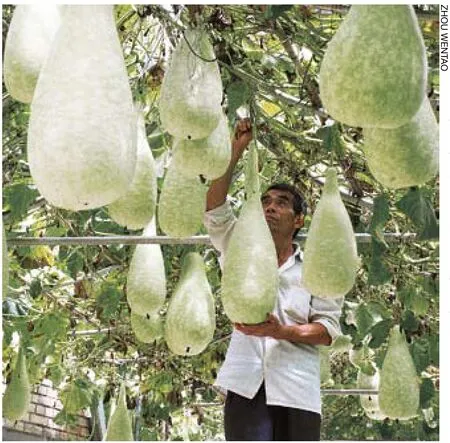The Space Odyssey of Seeds
Space plant-breeding technology is the future of agriculture
By TANG YUANKAI
Chinese yews are on the verge of extinction. A chemical extracted from their barks is used to produce drugs for cancer treatment, leading to overexploitation of the species. In addition to this, they are slow-growing and dif fi cult to breed.
To preserve the Chinese yews, scientists placed some of the trees’ seeds on an unmanned spacecraft at the end of 2002 for a space breeding experiment, hoping to use the experiment to achieve technological breakthroughs in the breeding, cultivation and rapid-growth of yews.
The yew seeds that returned from space were planted on the Earth, and it turned out to be a success. These space yews are now growing in a breeding base in Wuxi, a city of Jiangsu Province in east China. The yew breeding base is the largest of its kind in China.
It is not just seeds of this endangered plant species that have been fortunate enough to make space trips. In fact, the seeds of produce including rice, wheat, fruits and vegetables have all made journeys into the space.
Space breeding is a cutting-edge science that combines astronautics with agricultural and forestry sciences. Creatures living on the Earth are affected by its gravity and exposed to only low levels of radiation. But when seeds are taken into space, they are exposed to a special environment—a vacuum with minimal gravity and strong radiation, which makes the seeds prone to mutation.
Through space breeding, scientists intend to produce high-yield, disease-resistant plant varieties. So far, they have obtained several desirable traits through space breeding. For example, the eggplants grown from seeds taken into space have reached remarkable sizes. One such eggplant weighed more than 2 kg, and was the size of a basketball.
The experiments conducted by the Space-breeding Center of the Chinese Academy of Agricultural Sciences reveal that space rice contains 8 to 12 percent more protein than regular rice, and is more pleasing in appearance and pleasant in taste. Space peppers contain approximately 7 to 20 percent more vitamin C and trace elements than the varieties bred on the Earth.
“In traditional agriculture, it takes approximately eight to 10 years to breed a new variety, whereas space breeding can shorten the time period by more than a half,” said Liu Luxiang, chief scientist of China’s space breeding program. Space breeding is of signi fi cance to China’s food supply and realizing an increase in the income of farmers.
Nonetheless, some people worry about the safety of space-bred varieties. Liu explained that space breeding does not introduce any foreign genes, and is no different from natural breeding, except that it speeds up the natural process of biological mutation by means of factors in the space environment,such as strong radiation.

SPACE CALABASHES:A farmer in Tianshui Agricultural New Technology Demonstration Garden of west China’s Gansu Province takes care of calabashes,the seeds of which have made flights into space
Liu does not think that space breeding should cause safety concerns. “We have conducted strict testing on seeds that have returned from space, and have not found any increase in their radioactivity,” Liu said.
Space breeding is by no means as easy as sending seeds into space and retrieving them.“The seeds’ space journey is only the beginning of the space breeding process. More complicated and important work is done in the fields after space seeds return to the Earth,” Liu said.
After returning to the Earth, space seeds are carefully selected, as not all seeds undergo mutation in space (perhaps only 50 out of 5,000 seeds mutate), Liu explained. Seeds that have returned from space sometimes undergo further selection via conventional breeding techniques such as cross breeding.
Strains with desirable traits and promising market potential will be finally chosen and then receive further tests and evaluation.Before they are widely used, space seeds must pass examinations by crop-variety approval committees.
“Not all seeds will mutate into good seeds,” said Liu Min, a research fellow with the Institute of Genetics and Developmental Biology of the Chinese Academy of Sciences. Liu is also China’s first space science research medalist.
“In one of our experiments, some of the tomato plants we obtained were tall and strong, while others were short and feeble,and some were even freakish in appearance and sterile,” Liu added.
She said that she picked the best plants to produce the second generation, and still generated both good and bad offerings. “Usually,desirable genetic traits will become stable following the fourth generation,” said Liu.
China is one of the three countries in the world that possess recoverable satellite technology and is among the leading countries in space-breeding technology. The seeds of crops in China began their maiden space voyage on August 5, 1987, when a recoverable satellite for scienti fi c research was launched.Another significant step for China’s spacebreeding program was made on September 9,2006, when China’s seed-breeding satellite,Shijian 8, was successfully launched into orbit. The satellite carried a large number of produce seeds into space and landed safely after circling the Earth 236 times in 15 days.
In addition to seeds, Shijian 8 also carried some space environment probing and testing equipment, which enabled scientists to systematically analyze the triggering factors in space breeding.
“By better understanding the space environment, we can also seek to simulate the space environment on the Earth,” Liu Luxiang explained. He said that a number of significant advances had been made in this research area. ■

